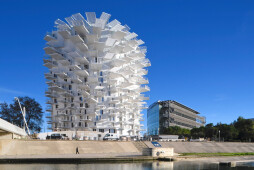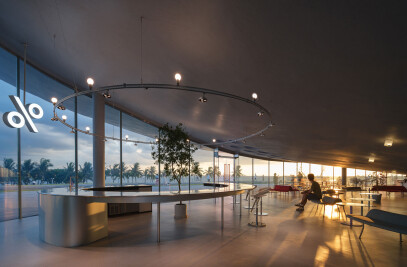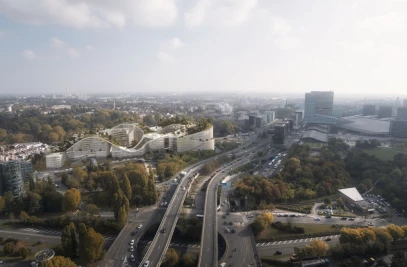In 2013, Montpellier city council launched the “Folie Richter” competition. It sought to identify a blueprint for a beacon tower to enrich the city’s architectural heritage. The RFP stressed the desire for a bold project that had to fit into its environment and includes shops and homes. Manal Rachdi, Nicolas Laisné and Dimitri Roussel decided to call on the Japanese architect Sou Fujimoto. All three of them seek inspiration in nature even if they express it in very different ways. On the Arbre Blanc, these four visions would be mutually enriching.
To reinvent the tower, the architects focused on the human dimension, creating public spaces at the bottom and top of the building: the ground floor is a glass-walled space opening out onto the street, while on the roof there is a bar open to the public and a common area for residents, so that even the owners of first-floor apartments can enjoy the view. But what sets the project apart is its design. The four architects devised a building inspired by a tree, with balconies that branch off the trunk and shades that sprout out of and protect its façade. The attention paid to its setting, and to local lifestyles, guided the architects throughout the design phase.
The many balconies and pergolas really do promote outdoor living and enable a new type of relationship between residents. Each apartment boasts an outdoor space of at least 7m² (the largest is 35m²), with multiple levels of privacy and layout options; residents of the duplex apartments can move from one balcony to the other. So that all apartments have pleasing views, the architects sculpted the blueprint with a series of spatial experiments using physical 3D models. The many technical innovations of L’Arbre Blanc include the terraces, whose cantilevers, which are up to 7.5 metre-long, constitute a world first. These exceptional outside spaces are fully-fledged living rooms which are connected to the dwellings in such a way as to allow residents to live inside and outside, a luxury for a city bathed in the sunshine 80% of the year!
The proportions of the balconies emphasise this aim to embrace the outdoors, as do the leaves that fold out in search of the sunlight. These generous balconies are also a response to the need for environmental solutions closely tailored to the “ecology of the south”. Forming an effective protective veil for the façade, they provide the necessary shade and break up skew winds to help air circulate more harmoniously. The architects adopted a new take on tower living for this mixed-use development. To cure inaccessible tower syndrome, there was a real focus on public space, including extending a landscaped park along the Lez River and opening the tower up to the public.
The seventeen-storey building is a full participant in city life, aiming first and foremost to be accessible to all the people of Montpellier, with an art gallery on the ground floor and a rooftop bar linked to a panoramic garden. By allowing people to take physical ownership of the tower, it will become an object of pride for the people of Montpellier and a tourist attraction.








































